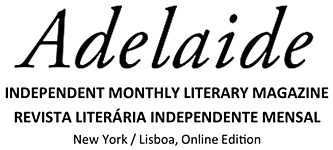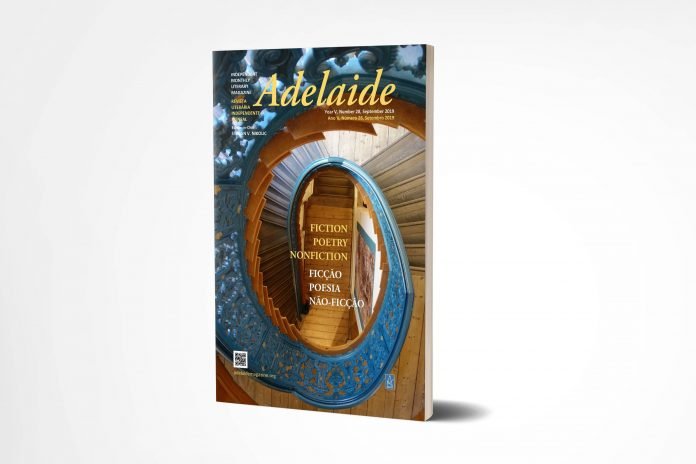PASSAGES
by Theresa White
There is a feather, the outer vain edged dark like charcoal ash, while the longer side bears an oyster shell lightness. Gathered from the yard, it has sat for years in my pen holder, amid the Bics, Uniballs, Pilots, and dull pencils in need of sharpening; it is less full than it once was as barbs have vanished, to where I know not. I like to pretend that if it had been found in the wood, hundreds of years past, that the feather would have become a quill and that the quill would write all sorts of missives, love letters, certificates, reports, notes, tidings, bills, communiqué, and poems. It would have been useful and beautiful, traveling the world by way of words on a piece of paper, folded and tucked into an envelope, addressed to someone on the other side of the globe.
When Ernestine, my husband’s grandmother, was close, so close, to death, her breath was leaving her body; her body was dispiriting, expiring, becoming a shell, she would have said ash to ash, dust to dust. Her vanishing act began as a decline, a recline, lying in bed, her head on a soft, so soft, pillow. The aides were out; the family was in. We circled her like a halo, murmuring words, whispering soliloquies, offering love, an offering. Her eyes were closed and her breathing measured. I remember her size. She had grown so small, as life was leaving and each breath exhaled. Her body a little thing, snug and blanketed. So much of life, her life, was diminished, diminutive, in all that was left, all that was there, after such a life, a big life, a full life, a life of largess and abundance, which sprang from something small and frugal. A return to small and sweet. And that was her smell, too: sweet as if each exhalation were held in a tiny, little, white lily of the valley bell, holding her breath in a cup, like a holy grail. Emanating from within her withering bloom, a full 101 years old, ready for a rebirth, she was still a flowery essence. Only when we had said our goodbyes, only when there had been a closing of the door and she was left with David, my husband, her grandson, did she exhale for the final time, only when the fine sweet scent had passed did he leave her and meet us on the other side of the door, to cry en masse and hold other hearts, beating, hurting, to his own.
I cannot fold what I think of as origami. I turn the paper into smooth geometric shapes as simple as rectangles and squares. They do not resemble tulips or boats. Let’s call my paper folding post-modern. But the art of paper folding is centuries old. Orizuru is the Japanese word for ‘folded crane,’ or what we know as the paper crane. My son can make origami like the orizuru by heart, an endeavor many master. I have one of his paper cranes, one that he gave me. Owen is my first born, a boy, who, when little, loved things with wings: butterflies, paper cranes, airplanes. The paper crane he made for me is a basic white. But that paper was utterly transformed: from recycled 20 lb. stock to a crane. A crane! I indulge my own amazement. Simple folds, but a complicated transformation. Flat to 3-dimensional, the crane should balance so that each wing is aloft. My crane now tips, one of his wings rests on the table. But of paper or crane, which is more beautiful? Which is more valued? The paper allows for these words, an invitation to a sister’s wedding, an obituary, a note to say, “I’m sorry.” The crane simply is. Mine devolving, a bit transfigured into a leaning tower of bird, one wing tip shouldering the weight of the entire creature. But it was built with love and care for me by my son, a boy, ready to fly, literally in the Air Force.
Menopause is a bitch, like a boss. I mean that in the most third-wave-feminist-I’m-reclaiming-that-word-kind-of-way possible. She is also a friend. She is that friend that curses and speaks too loudly in restaurants, making you laugh until you pee in your pants. (More than metaphorically.) Literally. I bemoaned my early onset menopause as the start of all things non-feminine. No longer menstruating, no longer of child-bearing age, no longer young, no longer visible, no longer. She has been less dramatic than I gave her credit for, but still ever-present, ever-pressing her ways on me, urging me to transform. But could it be that she is urging me to transfigure into a more elevated version of myself, beyond menses and to births of a different kind, births on paper? Essays and fiction and poems? Perhaps, I am not less gendered; I am more gendered, seeing through multiple perspectives. I now stand on the periphery, the edge of the borderlands, the fringe, a witness to it all. And I write.
My husband and I visited the little Austrian village, Hallstatt, which dates back to the 16th century. There is a lake, sheltered by a mountain range, and ringed by hotels. An espaliered pear tree decorates one charming home, and red geraniums pop. Oh, the geraniums! Up a hill, Catholic parishioners pray at St. Michael’s Chapel, until, upon their death, they are buried in its adjacent cemetery. Another afterlife custom continues in its charnel house, an ossuary or ‘bone house.’ With space at a premium, a new body would take refuge in an old grave and the old bones would be washed and painted with wreaths, initials or names, crosses, dates, and perhaps leaves or flowers—skull after skull, sitting on top of each other, over 600 of them, some centuries old, some decades. They’re quite beautiful. Laurentz Rogerl, Johanna Wesenfeld, Franz Seauer, Leopold Kieninger. The women’s skulls are smaller than the men’s. But the skulls are all the same: buried no more, bleached of bony color, the darker the ink, the older the skull. Alas, poor Yorick! The eye sockets and nose chambers hollow, devoid of the capacity to see or to smell. No more are they a part of the shell that made Wesenfeld whole or Seauer real.
Walking through the town, we step into an art gallery where a ceramist is selling pottery, her work a smooth porcelain glazed with an inky blue. We choose a vase, a squat 5 inch, a bulbous pot, with room for one stem. I wrap it carefully as we proceed across the country, before flying back to the U.S. The vase makes it back in one piece, ready for the mantel, the shelf, the table. It sits empty, a vessel, waiting to be filled. Now that I look at it, I can tell it’s a little askew. I like that. I fill it with a flower. The flower doesn’t last. It sits empty, a vessel, waiting to be filled again. The feather fits; now the vase seems an inkwell, ready to speak. There is a second Hallstatt, a copycat development oddly enough, in the small town of Luoyang, China. But there is no second off-kilter, blue-glazed vase, signed K.H.
The findings on a beach off the coast of Cape Cod, Massachusetts all look more appealing when wet. The wave creeps up the shore, painting the pebbles and shells a slick, more enhanced color than their naturally dry selves. The sun helps, aids in selling the goods. The rocks and broken bits seem to be saying, ‘“Pick me, choose me.” Half buried in the sand, some of those rocks and shells play the part of a stuck, stuck-up, stick-in-the-mud. They play coy; maybe they want to be chosen to go home with you, maybe they don’t. I pick up one rock, turn it over in my hand, examine its color and marks, and drop it like a bead of water sliding off the bottom of a drain. You are not the one. You do not speak to me. But then, soon enough, I am smitten. A grey rock pops, the sun pointing to it. Fitting easily into my hand, I curl my fingers around its girth. It is mostly round and lightly pocked. It appears as if something has made two lasting indents on its surface, like teeth marks, as if a sea nymph of unusual appetite bit into the rock, perhaps mistaking it for fruits de mer. As it quickly begins to dry in my palm, the color changes from a glistening gray to a bony beige, but where the teeth marks remain, there is a reflection of light—still shiny spots—luminous lines that persist. The rock is returning to Connecticut with me. The pudgy rock might has had its day near the surf, wet and wild, but I have tamed it, now it is dull and domesticated. We will live happily together, companions, a Boston marriage of sorts. Luckily for me, that sea nymph didn’t eat you up.
I see the design. We are to look our most absolute best, most attractive, most gendered, most sexual at the height of our, what, twenties? Find a mate; settle down; reproduce. We are perky and best suited for breeding. If only this thing called life were just a science experiment. But it is not. We get emotional. We are emotional. And we change. Our metamorphoses expose the truth. As Tolkien says, “All that is gold does not glitter.” And sometimes I miss the glitter. I didn’t value it, or even notice it, when I was a-glittering. But now, that time has passed. What can I retain? What can I renew? A sea change roils inside me and shows itself but haltingly. I am bitten with a consciousness that I am aging. But I gestate and will give birth to a new me, one that is a reflection of insight. It will be a croning. You are invited.
We once had five chickens. But a few days after they arrived, Lady Gaga died. That was her name. She was survived by Athena, Buffy, Mamma Mia and Ruby. The hens provided fresh eggs on a regular basis until they stopped laying. Athena was an iridescent black, tall, with a deformed toe. Buffy had a proclivity to peck at any egg left in the coop. Mamma Mia, a black and white hen ambled with the most sociable personality. And Ruby lived the longest. Luckily, my father painted little portraits of them before they passed. When one see chickens in art, in watercolors, and ceramics, on dinnerware, and tea towels, it is most often the rooster you see. His comb and sickle feathers protruding proudly with a true poser’s flair. My mother once gave me a little pewter rooster. He stood about 3 inches high, all because of that comb. This rooster was a little add-on, an extra gift, tied to the one I was supposed to open. She gave it to me because we had chickens. But our chickens were hens, not roosters. He’s fine looking fellow, a real fop, but he’s no hen, Senator Quayle. The rooster is the tenth sign of the Chinese Zodiac, and he may think himself the cock of the walk, but I’d much rather attend a hen party in the hen house, warm and woodsy. There they would roost or brood. A broody chicken could be a terrible hen, protective and tenacious, libel to nip at one and squawk if she were moved off that egg, that one incubating idea of creation. I might be a terrible hen, long past laying, but still brooding over ideas and writing, perhaps chicken scratch, but still—ever writing, writing.
About the Author:
Therese White is a writer from Connecticut and an MFA candidate from Lindenwood University, St. Charles, Missouri. Her work has been published in Caveat Lector, Cottonwood, River & South Review, X-R-A-Y Literary Magazine, and Smoky Blue Literary & Arts Magazine.



















